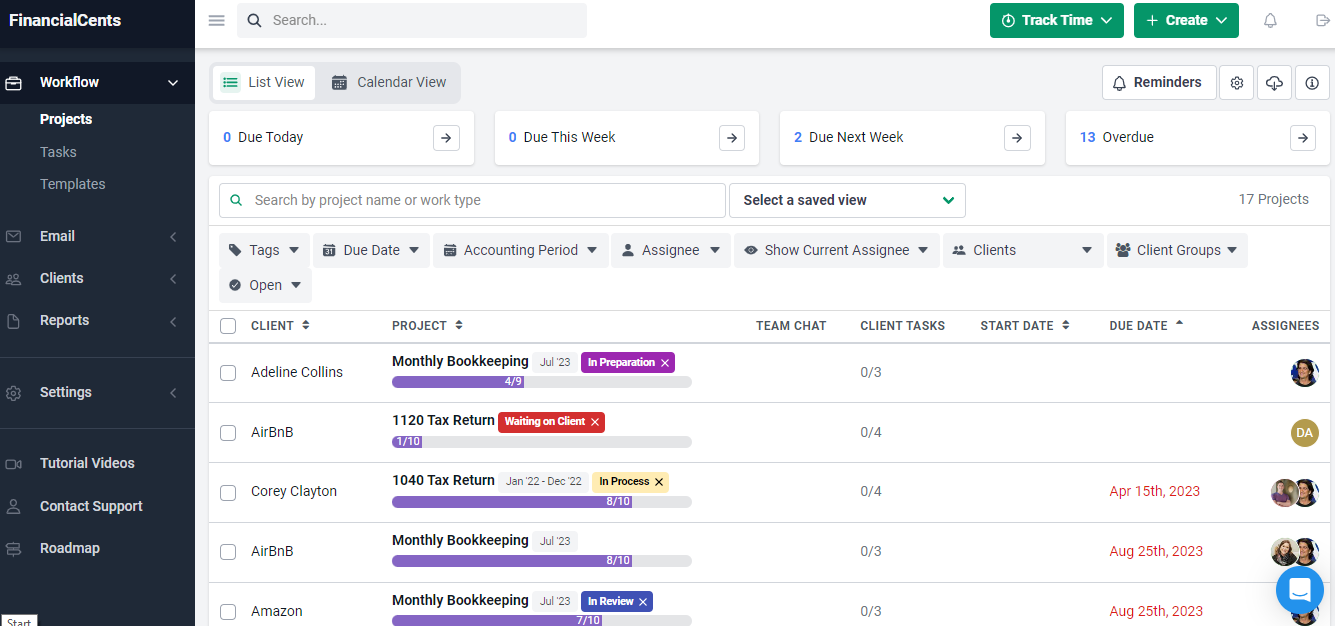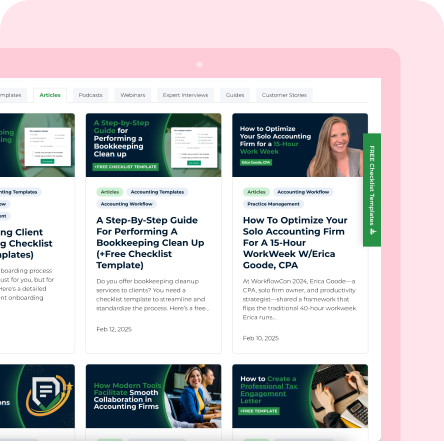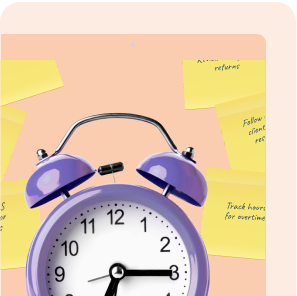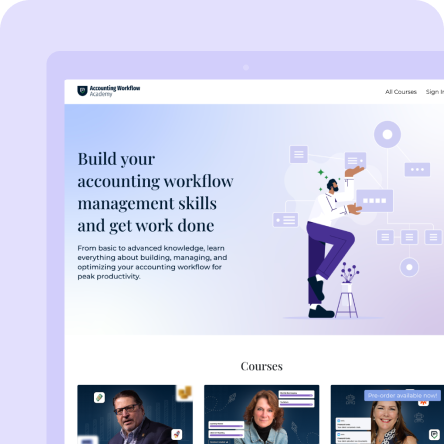What if you just planned reasonable goals for the week, got it all done, and felt 100% effective?"
Erica Goode, CPA.At WorkflowCon 2024, Erica Goode—a CPA, solo firm owner, and productivity strategist—shared a framework that flips the traditional 40-hour workweek. Erica runs a profitable, six-figure accounting firm and works 15 hours a week.
No burnout. No endless to-do lists. No hustle-for-hustle’s-sake.
Her strategy isn’t about shortcuts or working faster. It’s about planning—knowing exactly what to do, when, and why it matters.
This system isn’t reserved for accountants. Whether you’re a freelancer, entrepreneur, or solo business owner juggling client work, admin tasks, and personal responsibilities, her framework applies to you.
In this article, we’ll break down:
- The 3-step planning system Erica uses to manage her business in part-time hours.
- How to prioritize tasks so you’re always working on what moves the needle.
- Time-blocking strategies to protect your calendar from distractions and scope creep.
Let’s get into it.
The Burnout That Sparked a Need For Change
Before Erica became the poster child for work-life balance, she was a corporate high-flyer, racing up the ladder at KPMG and Walgreens.
The result? Burnout. The kind that leaves you questioning your life choices while clutching your third coffee by 10 a.m.
I felt like I was always dragging my kids behind me to and from work, always rushing. It wasn’t the life I wanted to live. It wasn’t the life I wanted them to live."
Erica Goode, CPA.Her burnout wasn’t just a crisis—it was a catalyst. Erica left her corporate gig, moved to a quiet town in Idaho, and accidentally started a solo accounting firm.
In a bid not to fall back into the same trap that led to burnout, she created her intentional planning framework—not just to run her firm efficiently but to design a life where work supported her, not the other way around.
The 3-Step Planning Framework
Step 1: Master Quarterly Planning
The foundation of an optimized 15-hour workweek starts with quarterly planning. This is about creating a roadmap that keeps you focused on what truly matters for the next 90 days.
Most people skip this step because it feels unnecessary. Why plan three months ahead when you’re barely managing today? But that’s exactly the problem. Without a big-picture strategy, you end up chasing urgent tasks instead of making meaningful progress.
If you want to feel accomplished in your day, you have to start by feeling accomplished in your quarter."
Erica Goode, CPA.Here’s how to master quarterly planning the way Erica does it.
Ask Three Critical Questions
1. What went well last quarter?
Don’t skip this. It’s easy to get caught up in what didn’t work, but acknowledging your wins builds momentum. Your accomplishments don’t have to be monumental. They just need to reflect progress.
2. What did I learn?
This question helps you extract lessons from both successes and setbacks.
“When a client let me go last quarter, it wasn’t a failure. It was a lesson in trusting my gut during onboarding,” Erica shared.
3. What are my priorities for the next quarter?
This is where the real work begins. Write down everything you want to accomplish in the next 90 days. Don’t overthink it—just brain-dump all your ideas onto paper. Accounting firm goals, personal tasks, random thoughts—get it all out.
Organize Your Priorities into Buckets
Once you’ve emptied your brain, it’s time to make sense of the chaos. Start by grouping your tasks into categories, or what Erica calls buckets. Her typical buckets are:
- Client work
- Marketing
- Admin
- Personal
“When I start compartmentalizing, it’s easier to plan. It’s like untangling a messy ball of yarn,” Erica explained.
Don’t worry if your buckets look different. The key is to identify natural groupings that make sense for your business and life. This step reduces overwhelm by breaking your massive list into manageable chunks.
Create Your 12-Box System
Now, it’s time to turn your priorities into a strategic plan. Draw a simple grid:
- Across the top, label your columns with your buckets (Client, Marketing, Admin, Personal).
- Down the side, label the rows with the three months of the upcoming quarter.
This creates a 12-box system (or more, depending on how many buckets you have). Start filling in the boxes with the tasks you identified earlier. Assign each priority to a specific month and category.
For example:
- Client Work (October): Onboard new client, and complete pricing review.
- Marketing (November): Launch newsletter, schedule social media content.
- Admin (December): Update financial plan, review tech stack.
- Personal (All Quarter): Family volunteer day, plan holiday travel.
This system gives you a visual roadmap for the quarter. You’ll see exactly what needs to happen and when, making it easier to stay focused as the weeks go by.
Commit to Your Priorities
The final—and most important—step is to commit.
If I decide I’m not taking on extra projects between Thanksgiving and Christmas, I write that down. Later, when someone asks me to do something during that time, I can say no without guilt because I already made that decision,"
Erica Goode, CPA.Quarterly planning is about clarity. When you know your priorities, you stop reacting to every new opportunity or distraction. You start making intentional choices about how you spend your time.
Step 2: Break It Down with Monthly Planning
Quarterly planning gives you the big picture, but that’s just the starting point. To turn those high-level goals into real results, you need to break them down into manageable, actionable steps.
Monthly planning bridges the gap between your long-term vision and your day-to-day tasks. Without this step, your quarterly goals can easily become just ideas on paper—forgotten as the daily demands of work take over. Erica Goode relies on monthly planning to stay aligned with her priorities, ensuring that every week moves her closer to her quarterly objectives.
“Quarterly planning sets the destination, but monthly planning is like checking the map to make sure I’m still on the right road,” Erica explained at WorkflowCon 2024.
Here’s how to break down your goals effectively, one month at a time.
Review the Previous Month
Start your monthly session by looking back at what you accomplished. This isn’t just about ticking off completed tasks—it’s about understanding what worked, what didn’t, and why.
Ask yourself:
- What did I get done this month?
- What progress did I make toward my quarterly goals?
- What unexpected challenges came up, and how did I handle them?
Identify Your Priorities for the Month Ahead
Next, turn your focus to the upcoming month. Look at your quarterly roadmap—the 12-box system you created—and identify the priorities assigned to this month.
Now ask:
- Are these priorities still relevant?
- Do I need to adjust any goals based on what happened last month?
- What specific actions will move me closer to my quarterly targets?
Erica recommends breaking larger goals into smaller, actionable steps. For example:
- Quarterly Goal: Launch a new service.
- Monthly Tasks: Finalize service outline, create marketing materials, schedule launch emails, and set up onboarding workflows.
Bucket Your Tasks
Once you’ve listed your priorities, organize them into the buckets you used during quarterly planning. Examples are:
- Client work
- Marketing
- Admin
- Personal
This helps you see the balance of your workload. Are you overloaded with client projects but neglecting marketing? Are you spending too much time on admin tasks without focusing on growth? Bucketing your tasks helps identify where to adjust your focus.
“Sometimes I look at my list and realize I’ve packed too much into one area. That’s a signal to either delegate, delay, or drop something,” Erica explained.
Step 3: Own Your Week with Time-Blocking
Quarterly and monthly planning give you the big picture, but the real impact happens at the weekly level. This is where strategic goals become daily actions, and where you either stay on track—or fall into the trap of busywork. The key to managing it all in just 15 hours a week is time-blocking.
Time-blocking involves protecting your time from distractions, unnecessary meetings, and the endless stream of “urgent” requests that can derail your focus. It’s a simple system, but when done right, it transforms how you approach work.
“I’m not productive because I hustle harder. I’m productive because I plan my time with intention,” Erica Goode explained.
Here’s how to master time-blocking and take full control of your week.
Review Your Monthly Priorities
Start by reviewing the priorities you set during your monthly planning session. What needs to happen next week to stay on track? Look at your quarterly roadmap, check your monthly goals, and identify the tasks that matter most.
This step helps you filter out distractions. If a task doesn’t align with your quarterly or monthly goals, question whether it deserves your time.
I’ve got shiny object syndrome like everyone else. But when I look at my priorities, it’s easier to say, ‘Nope, that’s not on the list,’"
Erica GoodeIdentify Your Non-Negotiables
Before you start blocking time, identify your non-negotiables—the tasks that absolutely must get done. These are often tied to:
- Client deliverables
- Revenue-generating activities
- High-impact business growth tasks
- Personal commitments that are time-sensitive
List these tasks out clearly. If your schedule gets tight, these are the priorities you protect at all costs.
Build in Flexibility
While time-blocking helps you stay disciplined, it’s important to build in some flexibility. Life happens—unexpected emails, urgent client requests, or personal emergencies can throw off even the best plans.
Erica recommends leaving buffer blocks in your schedule. These are open windows of time that serve as a cushion in case things take longer than expected or new priorities pop up.
“I don’t time-block every minute of my day. I leave space to breathe, because the goal isn’t to be busy—it’s to be effective,” she explained.
If something urgent comes up, you can move tasks around without derailing your entire week.
The 15-Hour Workweek Is Achievable
Optimizing your accounting firm for a 15-hour workweek is about intentional planning, clear priorities, and disciplined time management.
When you step back and look at Erica Goode’s framework, it’s not complicated. It’s simple, repeatable, and—most importantly—effective.
- Quarterly planning sets your long-term vision.
- Monthly planning breaks that vision into actionable goals.
- Weekly planning with time-blocking turns those goals into daily actions.
However, even the best planning system can fall apart without the right tools to support it.
This is where accounting practice management software like Financial Cents becomes essential.
Financial Cents helps streamline your workflows so you can:
- Track client work efficiently without missing deadlines.
- Automate repetitive tasks to free up more of your limited time.
- Improve team collaboration (even if the team is just you and a contractor).
- Gain real-time visibility into what’s done, what’s in progress, and what’s falling behind.
As Erica puts it, “I’m not productive because I have superpowers. I’m productive because I plan—and because I have systems in place that make it easy to follow through.”







